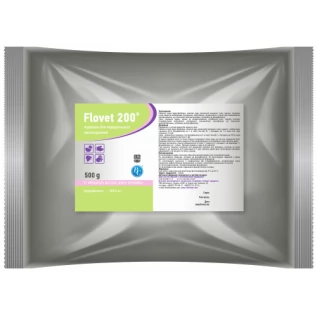Description
Powder micro-granulated from white to yellowish-brownish color.Composition
1 g of the preparation contains active substance:florfenicol – 200,0 mg.
Auxiliary substance: β-cyclodextrin.
Pharmacological properties
ATC vet classification code QJ01 - anti-infective veterinary preparations for system application. QJ01BA90 - Florfenicol.Florfenicol is a derivative compound of tiamfenicol, is active concerning gram negative and gram-positive microorganisms including: Staphylococcus spp., Streptococcus spp., Enterobacter spp., E. сoli, Pasteurella haemolytica, P. multocida, P. piscicida, Vibrio spp., Haemophilus somnus, H. parasuis, Fusobacterium necrophorum, Bacteroides melaninogenicus, Actinobacillus pleuropneumoniae, Bordetella bronchiseptica, Salmonella spp., Klebsiella spp., Proteus spp., Shigella spp., Aeromonas salmonicida, Campylobacter spp., Edwardsiella ictaluri, E. tarda, Flexibacter spp. and other. Florfenicol is active against most of micoplasma (Mycoplasma hyopneumoniae, M. hyorhinis and other).
Mechanism of the preparation action lies in bonding to 70S ribosomal subunit blocking ferment of peptidyl transferase, which cause to disturbance of amino acids transport and the next stop of protein synthesis in sensitive to antibiotic microorganisms.
In oral use, florfenicol is well and rapidly absorbed from alimentary tract and penetrates virtually to almost all organs and tissues, but its highest level is determined in lungs, kidneys, bile. In low concentrations, florfenicol is found in muscular tissue, liver, small bowel, heart and blood serum.
Bioaccessibility of florfenicol after oral use in pigs consists 88%. Maximum concentration of antibiotic in blood is achieved in 1 hour after oral use. Therapeutic concentration after oral use is preserved in organs and tissues for 24 hours.
Excreted from organism in unchanged form mainly by glomerular filtration, also excreted without changes into alimentary tract with bile, inactivated by chelate compounds formation, and then excreted with feces.
Application
Domestic poultry (broiler chickens, breeding hens, replacement chickens, turkeys): treatment of birds suffering from coli-infection, pasteurellosis, mycoplasmosis, salmonellosis as well as at diseases of pulmonary organs caused by microorganisms sensitive to florfenicol.Pigs: treatment of animals suffering from pleuropneumonia, atrophic rhinitis, Glasser's disease (рemophilus polyserositis), pasteurellosis, salmonellosis, coli-infection caused by microorganisms sensitive to florfenicol.
Dosing
Orally with drinking water or fodder at doses:domestic poultry (broiler chickens, breeding hens, replacement chickens, turkeys) - 20 mg of florfenicol for 1 kg of body mass or 0,1 of the preparation for 1 kg of body mass per day, or
- young birds to four weeks of age – 0,5 kg of the preparation to 1000 l of drinking water daily for 3-5 days;
- domestic poultry older than four weeks – 1 kg of the preparation for 1000 l of drinking water daily for 3-5 days.
. Treatment course: 3-5 days;
pigs - 5 mg of florfenicol for 1 kg of body mass or 2,5 g of the preparation for 100 kg of animal's body mass daily for 7 days.
In the period of treatment pigs and poultry should only receive water containing the preparation and such solution is prepared daily in the volume calculated for bird consumption during a day.
The preparation is dissolved in water at the ratio at least 1 l of water for 5 g of the preparation, which corresponds to 1 g of florfenicol for 1 l of water. The preparation is added to water (and not the reverse).
Should avoid long intervals between administration of regular doses of the preparation, as this may lead to reduced efficiency. In case of skipping one dose, application of the preparation is resumed in the same dose and by the same scheme.
Contra-indications
Do not apply to animals sensitive to florfenicol.Do not apply to animals in the period of pregnancy and lactation as well as to boars intended to reproduction.
Is not applied to laying hens, eggs of which are used for human consumption!
Do not apply at the same time with thiamphenicol and chloramphenicol, antibiotics of penicillines, сephaIosporins, fluoruquinolones group in connection of possibility of toxicosis arising.
Do not apply together with sulfanilamide preparations.
Do not apply when severe liver and kidneys function abnormality.
Warning
In the course of working with the preparation, using of individual protective means (respirator, gloves) is mandatory.The preparation is incompatible with preparations containing in their composition cations Mg2+, Al3+, Ca2+, since the last ones bind to florfenicol and prevent its absorption.
Slaughter of animals for meat is permitted in 6 days (pigs) and in 2 days (domestic poultry) after last administration of the preparation. Obtained before specified period meat is disposed or fed to non-productive animals, depending on conclusion of veterinary medicine doctor.
Form of presentation
Polyethylene film packages of 1, 2, 5, 10, 50, 100 and 500 g, 1kg.Sacks of 5, 10, 20, 25 kg.
Polymeric containers of 100 and 500 g, 1 kg.
Storage
Dry, dark, out of the reach of children place at a temperature from 5°C to 25°C.Shelf life - 3 years.
Shelf life after first opening of the package is 3 months under storing conditions at a temperature from 5 °С to 25 °С in a dry, protected from light place.
For applications in veterinary medicine!
